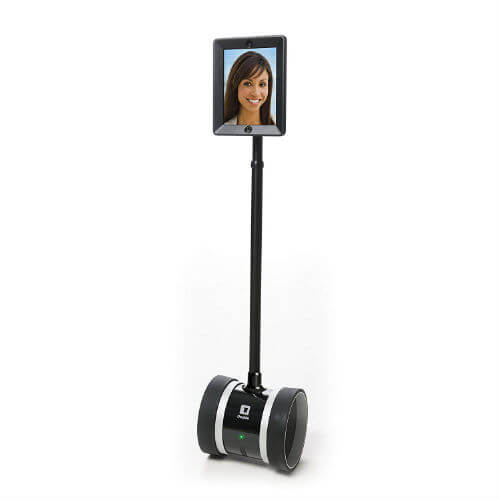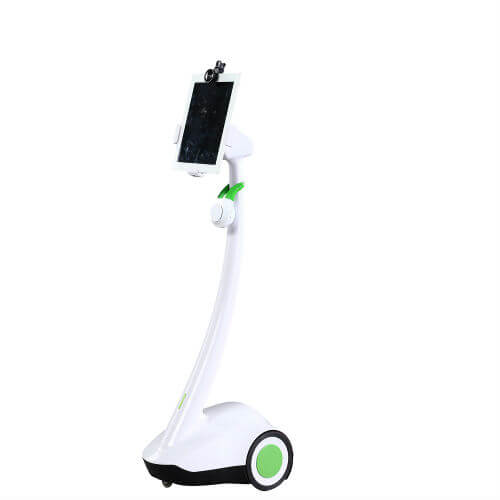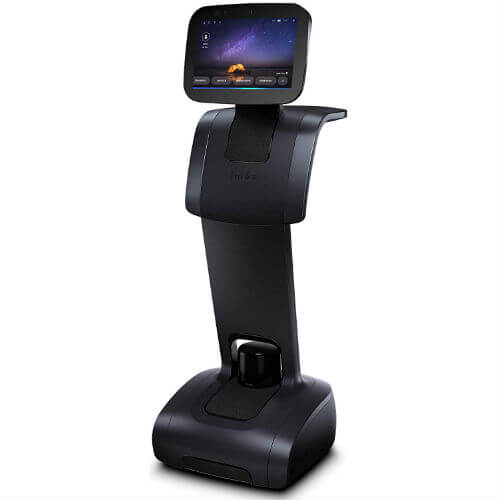Top Picks
Technology has come a long way, hasn’t it? I mean, the gap between stone tools (that some people in the office still seem to prefer) and mobile phones is dumbfounding, to say the least, but the influence of technological advancements has seen us witness levels of speed and convenience in communication and transportation is enough to get everyone born in this generation burnt at the stake for witchcraft.
Fortunately, it isn’t the 1100s, and science has civilized us to enjoy the benefits of instant messaging, social media, phone calls, video calls and other media that make communication an amazingly easy experience for everyone involved. Now, the best telepresence robots have been added to that endless list of communication channels that we have available.
*The product links in this post are affiliate links, which means that if you purchase after following one, I make a small commission from the sale at no additional cost to you. Please see our disclosure page for more information.
What is a telepresence robot?
Telepresence robots are devices used to simulate and transmit the virtual presence of the user with audio and video signals, and sometimes, gesture to other people. It allows people to get the feeling of being in another place in person, since the telepresence robot is equipped with enough bodily function to do so.
As for how or where they can be used, just like any other piece of technology, that’s down to two things: what you intend to use them for, and what they are designed for. A gun can be used by armed robbers to work on banks or can be used by umpires to start a race, similarly, there are no restrictions to the use of telepresence robots.
In the office, it can be an invaluable tool for corporate leaders who don’t have much time on their hands, a lot to do, and in dire need of some help with omnipresence. Equipped with displays and speakers for output, as well as cameras and microphones for feedback, telepresence robots take video conferencing to the next level by leveraging on its mobility to give off the feeling that the robot is an extension of the user’s consciousness.
On the business scene, it doesn’t take a genius to discover how they can benefit the communication links at the office, but that isn’t the limit of what the telepresence robots can be used for.
Medical telepresence robots have been developed to ease the stress on doctors, allowing them to accurately assess the situation by moving the robot around without having to be physically present. They can then simply advise their peers through the channels.
Injured children can also take advantage of telepresence to keep up with their studies, while disabled people can seize a new lease on life with an extra pair of eyes, legs, and ears.
Looking for a robot you can ride? Check out our review of the Segway Ninebot Loomo
The virtual presence devices can also prove their worth as your security surveillance agent to keep an eye on things when you can’t, as your butler or personal assistant to make the house warmer, or a special way to keep in touch with the family as some can be surprisingly autonomous enough to sustain themselves by docking themselves in their charging stations when their batteries go low.
8 of the best telepresence robots
1. Double Robotics Double 2 Telepresence Robot for iPad Tablet
After taking a few weeks to get used to the sight of my fellow workers stopping all that they’re doing to watch the double motor through the office hallway, there’s a lot to note about Double Robotics’ telecommuting creation.
First, it is very easy to control, and even easier to set-up. the sides you can move to are there for you to see on your controller device as the robot can be handled only by using an external device for executing the web-based controls. The WebTRC protocol is not compatible with Safari but using Google Chrome works out fine.
A big plus, is that there is a bonus feature to move the robot at close to double its normal speed called power drive. Since the robot has an extendable neck, the speed varies depending on how stretched out the neck is. The more the neck is stretched towards it’s 60-inch limit, the slower the robot will move.
One ingenious idea Double Robotics implemented was the strategic placement of a mirror in front of the camera that can provide so much assistance during navigation since it allows you a view of the ground. Also, while the double has remarkable balance, and its wheels are designed to climb over obstacles, it doesn’t change the fact that it is only meant for indoor use. Ignore all temptations to take it for a walk. I repeat, ignore all temptations to take it outside for a walk.
The double depends on internet connectivity for its control, and its WebRTC 128-bit AES encrypted video server is very sensitive to variances in bandwidth. So, expect to hit a few walls if your Wi-Fi isn’t working as optimally as it requires. And while the double comes with a headspace to fix your display iPad, it doesn’t come with an iPad.
There is also the option of not buying the camera and audio kits, but that would be a pointless move since you can rely on the tablets you put in for all that function. Of course, even with those expenses, this remote presence robot is a lot cheaper than many other telepresence robots in the market.
We have further details about the Doble Robotics telepresence robot in our full product review.
Pros
- The ‘power drive’ option allows you to save time when moving over long distances
- Has very simple controls
- Designed with incredible balance
- Has a neck that can adjust its height, offering even more reach and perspective than many other telepresence robots
- Designed to tread gallantly in rough terrain
Cons
- Doesn’t come with its own display
- App has a few glitches
- No auto-docking feature
2. PadBot U1 telepresence robot
Coming out of the package, the PadBot U1 puts the Double 2 Telepresence Robot to shame its stretchable screen holder, and it doesn’t stop there. The PadBot U1 also boasts a sleeker design than the double while its Auto-answering feature is something the producers of double could learn a thing or two from. Also, it’s a fraction of the price!
You must pair the controlling device with the robot before you can control it from anywhere, which means you should plan if you want to use this bot for a video conference.
The most amazing thing about the PadBot U1, though, is actually its resourceful autonomous performance. The PadBot is designed with sensor-assisted navigation tools to prevent collision with other objects, and even the ground, since it has an anti-fall feature that compensates the two wheels for better stability despite movement over large distances, but that just undermines the ability of the PadBot. For instance, when the battery power hits red, the robot automatically locates its charging dock and engages for a recharge. Even though it can run for eight hours after a full charge.
However, buyers must be warned that it is very expensive and has next to no support for English buyers, being a Chinese product. Except you are ready to wait till Nightfall to complain about your products to contact the only contact detail available, a Chinese phone number, you might have to stomach any complaints or inquiries you have.
Pros
- Has the auto-docking feature
- Has excellent battery life
- Has a very appealing design
- Has an anti-fall feature for better balance alongside its sensor-assisted navigation system
Cons
- Poor customer support
- You need to pair it before you can use it out of range
- Need to also buy the display device
3. Beam System for Remote Communications
The Beam came to the fore of telecommuting after it was introduced as a solution to assist motion-challenged people in providing a means of more effective communication.
The Beam telepresence robot has a less-than-impressive battery capacity that can barely manage two hours of continuous use, but its performance is ideal and second to none in the price range it is offered in. With double HDR cameras providing high resolution videos at 30 fps and a quadruple-microphone array complete with echo cancellation to deliver excellent audio and video quality to the receptors.
Just like the PadBot U1, Beam telepresence robots also have the automatic charging feature where they plug themselves to charging docks when the battery is low. However, the Beam has better support than the PadBot U1, with three years of annual subscription to the Beam support network on offer to buyers. The support extends beyond inquiries too, as it guarantees remote support from the customer support teams available.
Be sure to read our full BEAM Systems review.
Pros
- Good camera quality
- Has an amazing deck of microphones to produce quality sound
- Has the auto-docking feature
- Comes with a warranty and three years’ subscription to the paid service for better experience
Cons
- Poorest battery life in this list
4. Temi – The Personal Robot with Amazon Alexa
It seems like every passing day brings with it a new device for Amazon’s Alexa to get tied to, but with Temi, Alexa finally has a body of her own. Unlike other telepresence robots, Temi really comes alive when used at home, a telepresence robot that doubles up as your personal assistant and butler, programmed to follow you around your house and provide you with entertainment and information through its access to YouTube videos, Google for searches, CNN for news, Deedee for music as well as Reddit, Yelp, and even Uber. At least that’s what Temi was originally made for, before it got Alexa support.
Now, it’s 10.1-inch android tablet head offers you a solution to enjoy the full package of Amazon Echo while keeping your hands free for other tasks. For now, though, it falls short of the famous Echo Show because of the lack of an Alexa Smart Screen to boost the user experience, but that is believed to be in the works, per the words of Yossi Wolf, CEO of Robotemi.
Tweeters and woofers powered by Harman Kardon are extremely effective at getting great quality audio and bass vibrations that literally move your feet at close range. As a multimedia option, its link-up with Alexa makes it incredibly cool, after all, the appeal of voice commands gets to everybody in the end. What’s more? The robot is programmed to work in tandem with other smart devices in your home. this gives room for many nice gestures, like it can adjust the temperature of the house to your liking as it welcomes you back home if it is connected to a smart thermostat like the Ecobee thermostat, or turn on the light if you use a Philips Hue Bulb.
Also, Temi offers more than soft personal assistance, by means of its functionally designed tray, which provides enough space to help carry small items like phones, cups or small plates. While moving, it is also smart enough to recognize the difference between stationary objects like furniture and living beings like dogs or kids taking a rest, so it can quickly adjust its movements and go around them if they start to move through sensors placed at the base of Temi the personal robot.
Pros
- Comes with Alexa support
- Extremely good audio quality
- Its tray can be used to hold drinks, phones and other small objects
- Has the auto-docking feature
- Comes with its own display
- Great battery life
- Has inbuilt sensors to make it the smartest robot in this list
Cons
- Could use a better screen
5. KUBI Classic Telepresence Robot
It is classic beyond its name, and just like its name translates from the Japanese Language as the word ‘neck,’ the KUBI Classic telepresence robot design is a simple screen headspace on a flexible neck and then a base. The neck is extremely efficient, panning through 5/6 of a full circle smoothly while being able to nod through an angle of 45 degrees.
Unlike the first three robots, it doesn’t stand above 11.8 inches in height, but that doesn’t make it short by other measures. In a way, it towers over many telepresence robots when it comes to performance and innovation, especially since it actually performs!
The Kubi classic is infused with an ‘animate’ feature that allows the bot to playback any programmed motions along with the video feedback to further emphasize any points you feel the need to. The ability of the Kubi telepresence robot when it comes to learning is not limited to that alone, as it the developers left the door open for individual users to innovate their own additional features as they see fit through a public API – api.kubi.me.
As innovative as the Kubi classic robot is, the limitations of this robot are also very evident. It is a desktop robot, which limits its telepresent mobility to when it is placed on the desk. It is not built to move between rooms through remote controls like many other telepresence robots, talk less of automatic charging capabilities. It looks more like a fancy tablet holder.
Another weird thing is that there is no single app used in directing all Kubi’s functions.
Instead, there is the Kubi Control app and the Kubi Animate app. What makes it actually weird is that android users cannot get the animation app, and Windows phones don’t have access to the Kubi control app. This suggests that you would need both a windows phone and an Android device, or have an Android device to enjoy the full benefits of this telepresence robot, which is like I said, weird.
Find out more about the product in our KUBI classic review.
Pros
- Can record gestures
- Has the auto-charging feature
- Is open to creative input from users
- Has decent battery life
- Very flexible, it can tilt and pan even more than your neck can
Cons
- Cannot move around like other telepresence robots
- Should just have one app for all the features
6. Smart Telepresence Robot for iPad Tablet
This robot was created using Beam’s Smart Presence tech that enables it to detect obstacles and maneuver past them. Also, it comes with the auto-docking feature that allows it to find its way to its charging dock whenever the battery goes low.
The Smart Telepresence robot is controllable through apps available for android and Apple tablets. You will need to put in an iPad or Android tablet to serve as its head. It is compatible only with the iPad (4th generation), iPad Air, iPad (3rd generation), iPad 2, and iPad Air 2.
Pros
- Smart enough to avoid obstacles
- Has auto-docking abilities
- Is compatible with a lot of devices
- Good battery life
Cons
- Doesn’t come with a display screen
- Pretty basic design
7. BotEyes-Pad Telepresence Robot
This robot does betray its name by not having eyes, instead of relying on the user to put in a tablet for any auditory or visual input. The grip of the BotEyes-Pad Telepresence Robot is worthy of praise, though, as it extends enough to hold screens ranging from a size of 4″ to 11″.
The robot also has a docking station for charging, but is not programmed to automatically locate and connect itself to the charging station when it runs out of power. Its strength lies in its versatility of control, with its WebTRC protocol permitting all types of browsers to control the robot through any tablet. It’s maximum connection speed is just about 1.6Mbps, but that that depends on the device it is connected to, as its network connectivity favors Wi-Fi, as well as both 4G and 5G options. The quality of screen resolution similarly depends on how good the device used for display is.
The BotEyes-Pad Telepresence Robot at least has the auto-answer feature, but the dearth of extra features is probably why it has a running time exceeding 10 hours.
Pros
- Screen holder can be adjusted to accommodate a wide range of screen sizes
- Great battery life
- Has the auto-answer feature
- Can be controlled with different devices
Cons
- Does not have the auto-docking feature
- Relies on the device for most of its performance
8. Appbot Riley Home Security Robot
If security is what comes to your mind when the concept of telepresence robots is told to you, then Apologize Riley could be the thing for you. With a design that allows it to run through rough terrains unperturbed, even though it looks so small and cute, Appbot Riley boasts a strong list of features that guarantees your peace of mind.
Night vision and motion detection sensors using image processing head up that list, backed up with a HD video camera and high-quality microphones for clear transmission of live video and audio.
Some other features of Appbot Riley could be used for other reasons, like its attached memory allows the bot to save videos of lengths less than ten seconds, and it can also be used to make announcements through its capable speaker.
As for the security of this security measure, Appbot Riley has a two-step verification password system in place alongside encoded video feeds to protect your data. Unfortunately, you can never be sure if that is enough to guard against hacking. Physically too, while it is extremely sturdy and well balanced, the Appbot Riley is not invincible and can be damaged, even by water, since it isn’t waterproof.
To be honest about it all, Appbot Riley will be a fun addition to shore up your defense, but you must not convince yourself that the robot is sufficient to work alone as a security system for your house, it’s value is in being an additional surveillance camera for your security system and providing some entertainment for the kids, it’s not a security guard.
Pros
- Extremely cheap
- Great video quality
- Has great balance
- Has depth in volume of sound through great speakers
- Has night vision and other modes that make it a security asset indeed
Cons
- It can save videos, but the ten second-clips make the feature look like a joke
- Cannot stand alone as a security system
Buyer Guide & FAQs
What to consider in the best telepresence robots
Almost any robot is cool to have, but since you’re shelling out money, and not sand, for telepresence robots, getting value for each cent is obviously important. Choosing a telepresence robot wholly depends on the function you have in mind for the telepresence robot, however, here a couple of things your choice must have.
Great camera quality and an even better screen
It would really suck if you had to guess the shape of the head of who you’re talking to. So, having a good camera is something to watch out for. Similarly, you also want the people you’re trying to reach know you’re okay, to put their minds at ease, choose a telepresence robot that has enough screen resolution and display quality to project you as clearly as possible.
Audio
In a sense, the audibility of a telepresence robot is the biggest yardstick of its value. After all, communication is not valid until a message is passed, and visual cues might not be as effective as words.
Connectivity options
The best telepresence robots have a wide range of options they can be connected to. This flexibility will allow you to breathe easy in case there is a fault. That way, they can still be remote presence robots.
Degree of freedom (mobility)
The distinguishing feature of telepresence robots is their ability to roam and give the user different angles to look at the environment. The least you should go for is a desktop telepresence robot, if can’t move, it’s not much of a presence.
Other features
Does the telepresence robot have any other cool feature apart from being a virtual presence device? Can it fly? Does it have an Alexa integration? Does it have the auto-docking feature so you don’t have to take care of another baby? Take this chance to choose what you would like your tech companion to be able to do.
Key points for consideration before buying a telepresence robot
Ease of Operation
I once had to pass a compulsory and difficult test in every scene of a game I played when I was younger, it wasn’t my favorite game. You don’t need that stress either, you’re paying money to ease your burdens, it better not be a source of stress.
Durability
Material selection aside, does the remote presence robot have features that preserve its longevity like sensor-assisted navigation or a clever design for better balance.
Customer Support
If you choose to buy the telepresence robot as a gift, for an elderly person for example. Setting it up and making complaints should be channeled to the right people, if not, the entire investment could end up a huge waste. So, make sure there is someone you can talk to if you have any qualms before clicking the ‘buy’ icon.
Warranties and Security
Factory defects are not common these days, but they do happen. If you get a product with a factory defect, do your best so you can rest assured in a warranty. Similarly, try to find out if the video transmission is encrypted per standards so you can communicate relaxed about your security.
FAQs
How do telepresence robots work?
The robots require internet connection to function. This could be through Wi-Fi, 4G data networks, or other wireless options. Also, some telepresence robots come with a display screen and some others require that a tablet be placed on their headspaces. Regardless, the remote presence robots are usually controlled through apps or browsers specified by the designers, and have different controller interfaces. The user sometimes must pair with the robot before he can operate it from afar, then they simply use the app or browser to control the robot like an immersive video game platform.
What is a telepresence robot used for?
The limits of the use of telepresence robots lies in the imagination of the user as telepresence robots have a long list of uses. Some include:
- They take video conferencing in a business settings to the next level by allowing user to look at different visual perspectives and make some limited gestures.
- Some sturdy robots can be used to tour properties by real estate investors who are far away to see how the property really is.
- Doctors can check in on their patients without having to even leave their homes.
- Families can keep in touch with their elderly ones in nursing homes.
- Telepresence robots can act as surveillance agents to patrol and see in detail if anything is out of place.
- Children that can’t attend school, maybe due to health reasons can attend school and take lessons
What if I don’t have a reliable wi-fi source?
Many telepresence robots operate using cellular networks like 3G or 4G, and typically consumes little amount of data for simple controls. The data-usage however depends on the network providers.
Do the robot manufacturers demand extra fees for using the server?
It is likelier that you don’t incur extra fees from your manufacturer for using their servers. However, some manufacturers could provide some extra features that will require regular subscriptions.
Are stationary telepresence robots, robots at all?
Yes, they are. While they cannot be driven around like other robots, they offer their screens can still be tilted and panned to different angles.
Final thoughts on the best telepresence robots
Telepresence robots are in a way, the tech companies’ attempt towards sci-fi movies and their mouthwatering holographic and teleportation gimmicks. It is a solution that affords the user another way ‘to get around’ without being there personally. Have a need to be at two places at once? Trying to reach out to family, friends or other people in faraway places? Or are you completely unable to move? Telepresence robots provides the new logical answer to those dilemma, and so much more!

Matt is the founder of the Little Robot Shop, who has spent much of the last decade hacking home cleaning with various robots and devices to make keeping his home clean as easy as possible. Not an easy task with two young children.
When not working on the Little Robot Shop website or YouTube channel, he works as technical support and product specialist for a fast-growing digital company. He does his best to get his younglings to code, which will be an essential skill in the future.




